#imagine a pandemic that targets people like you
Explore tagged Tumblr posts
Text
Sometimes something puts me into my context as a queer born in the 80s and growing up in Section 28 England, and there's nothing else really to do except have a little cry about it.
“There’s a generation of queer people grieving for the childhood they never had,” Haigh says. “I think there’s a sense of nostalgia for something we never got, because we were so tormented. It feels close to grief. It dissipates, but it’s always there."
#queer#i was too small to know it was going on#and by the time i was old enough to understand it was too late#when i try to imagine a childhood without anti-queer and anti-trans violence as a cultural influence i just go totally numb and empty#like flipping a switch#you've all had a pandemic now right#imagine a pandemic that targets identity#imagine a pandemic that targets people like you#if you catch it you will die a slow and painful death and infect the people you love the most#and everyone else thinks that it's killing you because you are you#and 75% of the population thinks who you are is an abomination#and so no one cares that you're all dying#and then imagine that instead of it happening to you as an adult who can process that. it's happening to you as you develop a sense of self
51 notes
·
View notes
Text
The Test, chapter 4
Jack opened his eyes slowly, feeling a familiar weight on his chest. He was lying on a metal stretcher, his hands and feet firmly strapped with leather restraints, immobilizing him. The air in the room was heavy, oppressive, and the darkness was only interrupted by the glow of the machines around him. Beside him, a monitor displayed a real-time electrocardiogram and echocardiogram. The image of his heart, enlarged from prior testing, beat with a steady, powerful rhythm on the screen. The beats felt deeper, stronger, as if his heart had evolved after the tortures it had endured.
For a moment, Jack found himself fascinated. Despite the fear, pain, and suffering, he couldn’t stop staring at the screen that projected his own heart. The organ looked strong, robust, even after everything it had been through. But that fascination was soon replaced by a disturbing question: What would Dr. Ruiz do next?
Suddenly, Ruiz's voice echoed through the room via a microphone, clinical and calculating in tone. "Jack, I see you’re awake. I assume you remember that your heart started beating again after ten minutes of resuscitation. It was a challenge, but your heart is... fascinating. Resilient. However, this is far from over. The real test begins now."
Before Jack could process the doctor’s words, the atmosphere in the room began to change. The temperature rose rapidly, turning the room into a stifling oven. The air, already heavy, became almost impossible to breathe. Jack tried to gasp for air, but there wasn’t enough oxygen. Instead, a pink gas began to seep into the room.
"That gas you’re breathing, Jack," Ruiz continued, his voice terrifyingly cold, "is a bacteria designed to attack the heart at a structural level. Its goal is to degrade it, break the fibers, and weaken the muscle from within. If your heart doesn’t deteriorate during absorption, it will mean it’s immune... that your heart is, essentially, perfect. But if it’s not… this is the beginning of the end for you."
Jack felt his mind clouding as a memory surfaced. There had been a pandemic, many years ago, that ravaged the world—a disease that specifically targeted people’s hearts. Now he understood: that disease hadn’t been an accident. Was this part of some larger plan? Had they created the bacteria now infiltrating his body?
As his thoughts spiraled, he felt the gas brush against his feet. The cold touch of the gas, in contrast to the stifling heat, sent a shiver through him. Jack tried to resist, but it was impossible. The gas seeped into his nose, slowly invading his body. He could feel it filling his lungs and spreading through his system. A deep fear consumed him as he imagined what the bacteria would do inside him.
With his heart pounding faster, he turned his head toward the monitor. The echocardiogram showed an acceleration in his heartbeat. Faster and faster. Fear consumed him, yet strangely, his body showed no other symptoms. His heart, though agitated, kept pumping strongly, resisting the attack.
Thirty minutes passed. Jack continued watching the screen, expecting something catastrophic to happen. Each beat echoed in his ears, the only sound in the silent, oppressive room. But, surprisingly, his heart showed no signs of weakening. The pain he had feared never came. There was only the quickened pulse and the growing fear, but physically, he was fine.
Sweat dripped down his forehead, and his breathing, though rapid, remained regular. The pink gas kept filling the room, but his body resisted. Could it be true? Could his heart be immune, as Ruiz had hinted? Was it… perfect?
Note: after publishing this story, I'm planning to write another dark cardiophile novel here, but I would like to make a casting for the characters hearts. So, if you are a male cardiophile, you can send me by dm your EKG, Echo, Heartscans, your heartbeats, etc. And also, like a plus, photos of your male soles 😁 I'll give You credits.

#male heart#gay heartbeat#male cardiophilia#echocardiogram#beating heart#heartbeat#dark cardiophilia#gay men#cpr resus#male heartbeat#male soles
58 notes
·
View notes
Note
I enjoy reading your opinions and rants about how fandom evolution, the repackaging of purity culture, and the social media landscape has created some questionable and awful behaviors amongst readers.
Maybe it's because I'm a newish(?) follower, but I haven't seen many posts of how the same factors affect fandom authors. (This isn't targeted towards you, but more so general fandom spaces, so to speak). I respect your opinion, so I'll just ask.
1. What behaviors that you see other fandom writers do that gets under your skin? 2. Any thoughts on the social-mediafiction on fanfiction culture as whole? I would appreciate your thoughts on this.
Thanks in advance, Vox!
I'm glad you enjoy my ramblings ❤
I don't tend to get into these discussions often, mostly because of a lack of time and energy, but sometimes, some post or event really gets me going—and they come in clusters a lot of the time. I have talked a bit about author behaviors too, but I think most of those posts are quite old—as in, pre-pandemic for the most part, with a few scattered across the last two years or so. They were largely related to bigger discussions on other, fandom-focused blogs I follow.
Re your questions, I can answer them as one because people treating fanfic sites, especially Ao3, like social media and/or hustle culture is my main pet peeve with fic authors.
At the center of it is monetization. That grinds my gears like nothing else. I'm not talking about authors having a tip jar on their blog or someone in a desperate situation taking commissions. But there's this increasing tendency to turn writing fic into a career, not by shifting to original fiction but by monetizing fic itself, and I view that as being fundamentally antithetical to fandom culture. Online fandom is a gift economy—a free exchange of passion, to put a pretty spin on it. That's both one of its defining features and most appealing aspects. There's no barrier to entry, aside from possessing a functional internet connection. Your age, geographical location, financial status, or any such factor doesn't affect whether or not you can participate in fandom, as a reader or a writer (or an artist in general, save for money-intensive stuff like cosplay). Monetization puts a rather sizeable wrench in that, especially when it comes to practices like posting a few chapters for free and putting the rest on Patreon.
Also, frankly, money changes things. All those issues I've talked about regarding entitlement and purity culture will be compounded when there are financial incentives to writing and posting fanfiction. You already have people who think fic writers exist to cater to them personally; now, imagine how people like that would act toward someone they've given money to, whether it's a systematic plan like Patreon or something more voluntary like tipping. Yes, the majority of people who pay writers aren't like this, just like the majority of fic readers in general are lovely people. But we've all also seen the damage that small toxic minority can do. Similar principles apply in relation to purity culture. People are already shit-scared of writing "problematic" topics because there might be witch hunts and doxxing; if they become reliant on fandom as a source of income, creativity will be further stifled (and sanity will probably go further downhill, let's be real). This is already an issue with original publishing, and I'm only in the periphery of those discussions.
Clout-chasing and comparison are two another issues that already exist in fandom and will be worsened when money's in the equation. Venture into r/Ao3 or r/Fanfiction, or any such space for discussing and venting about fandom and especially fics, and you'll find no shortage of people who are angry, sad, discouraged, disillusioned, or otherwise upset about getting less engagement than others in the fandom. To be clear, I'm not denigrating anyone for being sad about posting into the void in general; I'm talking specifically about the disappointment and jealousy arising from comparison. If "I only got X kudos even though Author A got XX kudos for posting the same trope" becomes "I only got X dollars even though Author A got XX dollars for posting the same trope," I'm going to yeet myself into the sun.
And this is the tip of the iceberg. I'm brushing very briefly (hah) on the impact growing monetization can have (and is having) on fandom's social dynamics alone. The legal grey area is a whole other beast. The ethics can be a debate of its own. The specific matter of people posting Patreon and Ko-fi links on Ao3—a volunteer-run, fan-funded platform that explicitly disallows monetization for both legal and social reasons—and then whining when they get penalized could be its own essay. I've seen motherfuckers straight-up argue that Ao3 is taking away their right to profit from their labor.
Seriously, I could talk about this forever. I have bouncing thoughts on specific aspects, from the proliferation of for-profit digital zines to the treatment of one's fic readers as future book buyers, but this post is already too long. I also have pet peeves regarding author behaviors unconnected to monetization, though those are also mostly related to clout-chasing and competitiveness and other nonsense that treats being a fic writer as akin to being an #influencer. Plus, there's no clean split between authors and readers in fandom, so a lot of the stuff I've said about readers being dicks generally arises from fellow writers.
Okay, shutting up now 🤐
TL;DR: Treating fandom like social media or a source of income is a bad idea. Don't do that.
21 notes
·
View notes
Text
Tolkien Black headcanons !!!!!!
Tw for multiple mentions of getting shot
Non-binary + romantically attracted to girls (based on Tupperware character description), pronouns - he/they
A bit of a Math+physics nerd + one of the best students in class (Cartman canonically cheats off of them on tests sometimes)
Has a really healthy and wholesome relationship with their parents + they sometimes either intentionally or unintentionally embarrass him in front of his friends but all in good fun (think of Ninjago Jay's relationship with Ed and Edna for reference)
Bit of a complicated relationship with Nichole (canon but i forgot in which episode it was said, but Nichole told Cartman that she and Tolkien are having some issues in their relationship? But it's not any of Cartmans business) (though he loves her and they even canonically have a picture of them together in his room)
Best friends with Craig, Clyde's a close second
Already mentioned it in my Craig headcanons posts but before Craig got with Tweek he would joke about proposing to Tolkien in the future so he could live off of their and their parents wealth lmao
Most serious/realistic??? out of Craig's gang
Has a bit more goofy / derpy side but is mostly embarrassed by it
Voice cracks in the future come to be the death of him
TW TRAUMA + POLICE BRUTALITY - is still quite distraught from being shot in the arm by a cop (in South ParQ Vaccination Special? Or was it on The Pandemic Special?) and is still distraught from that time his parents were arrested for no reason (in TFBW, where they also constantly targeted him and treated him (a ten year old child) like a threat), especially since most their childhood, like all the other kids, they were told that cops are their friends they can trust! But now he knows he can't trust them and avoids them whenever possible
Friendly
Canonically likes basketball (I like to imagine they sometimes play with Kyle!)
Favorite colour is purple (NO WAYYYY WHO WOULD'VE THOUGHTTTTTT /s)
Canonically feels out of place sometimes because of their family being rich
Sometimes takes the role of "the mom friend" (idk why. based on vibes. screw me)
Cringe TikTok user (canon 😞)
Not too much of a nerd like his dad
Since they actually hate that their name is Tolkien (cuz they don't like JRR Tolkien's books) maybe they change it in the future? I don't know what to though (but sometimes likes Token better)
Kind of understandably tired of everyone's shit
Wendy once said "I've dated him before, he's really nice!" or something like that sooo I take it as canon
Hates Cartman and has every single right to do so (he threw a rock at their head, shot them, and is just a racist asshole all the fucking time to them 😭😭)
But wait - what I don't understand is that they said "all that dungeons and dragons shit is lame" but in the stick of truth (haven't played it, only saw like 2 scenes in it) they were fully on board with playing fantasy? Like -

"THANK YOU FOR THY MESSAGE, TRAVELER! I SHALL MAKE HASTE TO KUPA KEEP!" - that sounds pretty nerdy to me Tolkien. Maybe they DO like nerdy shit but are just embarrassed to be associated with it???????? Idk I'm starting to get confused. Tolkien hyper fans / analysts if you're out there please help me
Canonically plays bass and still has his bass guitar in his room as shown in TFBW
Good person that usually puts others before themselves (like when Cartman told him to "be the bigger person" and tricked him into going over to him and getting shot by him)(still stands his ground and doesn't let people walk over him)
On southparkstudios.com it was said they're good friends with kenny and share struggles related to income (opposite sides of the same coin) so maybe they hang out sometimes. that'd be kinda cool.
Cat person I've decided though I don't think he cares too much abt the dogs vs cats debate
Gifted + talented kid but sometimes might be a perfectionist with overtly high expectations for themselves???????? Idfk what I'm on dude
Good memory
Likes to roleplay
Can't tell if he prefers fiction or nonfiction cuz of stick of truth but also because of the whole hating his name thing Eufhfhfuufnceucb
Ermmmm i think that's it for now Byeeeee god im so cringe
#sp#south park#tolkien black#token black#sp tolkien#tolkien sp#south park tolkien#tolkien south park#sp token#token sp#south park token#token south park#tw police#tw gun mention#tw violence#south park headcanons
12 notes
·
View notes
Text
'The Role of Influencers in Public Health Messaging: How Social Media Influencers Can Drive Awareness and Change.'
MDA 20009 Digital Communities
Did you know that there are approximately 5.16 billion active social media users worldwide? On average, people spend 2 hours and 23 minutes a day scrolling through their feeds, liking posts and watching videos (Larson, 2024). In today's world, we rely more and more on social media for news, advice and trends. This makes influencers – people who can shape public perceptions and behaviours – some of the most influential voices in public health communications. Global surveys show that younger audiences are turning to social media influencers (SMIs) for information about important issues like health, rather than traditional news outlets (Newman et al., 2023). As public health organisations keep on looking for ways to engage large and more targeted audiences, they're increasingly turning to influencers as key partners. Social media influencers, with their extensive reach and close connections to their followers, can have a big impact on how health information is received, understood, and shared.
Understanding Why Influencers Are Effective in Health Messaging.
In the age of social media, people are often more connected to brands, media, celebrities, and influencer content than to their personal ‘real-world’ networks (Pöyry et al.). Social media platforms like Instagram, TikTok and YouTube use algorithms that show popular and engaging content more frequently, and when you combine that with the followers and appeal of influencers, the impact is huge. Traditional healthcare providers just can't compete on that level.
A key factor in their effectiveness lies in the nature of their relationships with followers. Reinikainen et al. (2020) studied how one-sided 'imagined' relationships between followers and media figures – what we call parasocial relationships – can affect the effectiveness of endorsements. This connection means influencers can share public health messages in a way that feels more personal and friendly, rather than like they're telling people what to do. Unlike traditional experts, influencers gain people's trust through the honesty and reliability of their online presence (Pöyry et al., 2022). This trust can encourage people to take action, especially younger audiences who value authenticity over authority.
Social influence theory further reveals the reasons why influencers are successful in shaping behaviour. The theory suggests that people are influenced by information about desired behaviour and observations of others' behaviour (Kaplan & Miller, 1987; Wood, 2000). Influencers act as opinion leaders in the digital space, setting social norms that prompt followers to adopt. For example, when influencers promote vaccination or fitness, they establish a normative influence that makes these behaviours more socially acceptable and popular among their audience.
In addition, influencers' ability to promote weak ties - the bonds that connect distant social networks - allows them to spread health messages far beyond their immediate follower base (Bakshy et al., 2012). Coupled with the interactive and participatory nature of their content, influencers are well positioned to amplify the impact of health campaigns, reach underserved or hidden audiences, and drive meaningful behaviour change (Pöyry et al., 2022). This combination of personal connection, social influence, and algorithmic visibility gives them a unique role in public health communication.
Case Study: COVID-19 Public Health Messaging
During the COVID-19 pandemic, influencers were key in sharing health info during the pandemic, and Dr Mike Varshavski is a great example, popularly known as "Doctor Mike." He's a licensed doctor and social media influencer with millions of followers on YouTube, Instagram, and TikTok, he effectively bridged the gap between scientific information and the public.
Dr Mike uses his platform to expose misinformation, explain complex health topics such as vaccine efficacy and wearing masks, and share updates on COVID-19 guidelines in an approachable and engaging way. His credibility as a medical expert, coupled with his down-to-earth style, has helped him win over a wide audience, especially younger demographics, who might otherwise stray from traditional health communication channels.
Here are some example videos and short posts by Doctor Mike related to the COIVD-19 pandemic:
youtube
youtube
youtube
Research has shown that during a pandemic, information shared by influencers is more likely to be accepted, especially when it is presented as part of their own life story, struggle or journey. In addition, people tend to be more willing to share such content because of its personal and accessible nature than official government information, which many consider remote or inaccessible.
The Pros and Cons of Influencers in Public Health
Pros: Increasing Awareness and Engagement
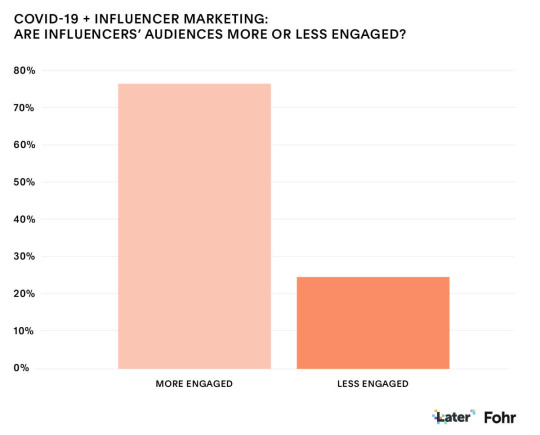
Data shows that influential audiences are more engaged during a pandemic.
Social media platforms are powerful tools for public health because of their broad reach, high engagement levels, and the ability to tailor content to target audiences (Kanchan et al., 2023). Influencers can make health content engaging, accessible and shareable, thereby initiating conversations in online spaces where younger audiences are more active and receptive. Furthermore, influencers' personal connection with followers often makes them more persuasive. As opinion leaders, they have the potential to motivate people to take preventive actions and promote healthy behaviours, whether through fitness routines, mental health tips, or updates on health crises.
Cons: Risks of Misinformation
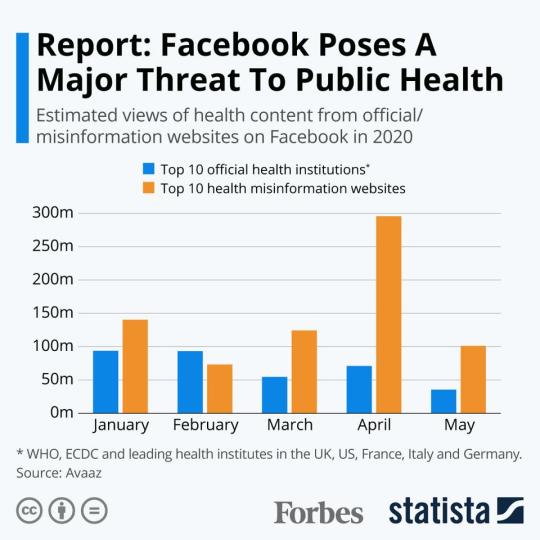
Report in 2020 shows that Facebook has posed a significant threat to public health.
While influencers have the potential to spread good information, they can also spread misinformation. Some influencers have promoted diets, supplements and health claims that are questionable, unproven or unfounded. For instance, Jenkins et al. (2020) observed how certain influencers, often with large followings, shared damaging fad diets without any consequences, while Leader et al. (2021) explored the spread of anti-vaccine sentiments by influential mothers on social media. A 2021 study by the Centre Against Digital Hate found that 65 per cent of anti-vaccine misinformation on sites such as Facebook and Twitter can be traced back to 12 influencers. These cases show how dangerous it can be when people with a lot of influence don't have their messages checked, as misinformation can spread quickly and endanger public health (Michel et al., 2024).
Conclusion
In summary, social media influencers are pivotal in public health communication, using their broad reach and personal connections with followers to drive awareness and behavioral change. Followers trust influencers as relatable voices, often engaging more actively with their messages than traditional health campaigns. While influencers can amplify accurate health information, they also risk spreading misinformation, as seen with questionable diets or anti-vaccine sentiments.
To maximize their impact, public health organizations must partner with credible influencers, monitor content for accuracy, and provide reliable resources. With responsible collaboration, influencers can effectively engage diverse audiences, combat misinformation, and promote positive health outcomes on a global scale.

Thank you for reading, see you in next post <3
Reference:
Larson, S. (2024, April 8). Social Media Users 2024 (Global Data & Statistics). Priori Data. https://prioridata.com/data/social-media-usage/#:~:text=As%20of%202024%2C%20there%20are%20approximately%205.16%20billion,platform%2C%20with%20over%203.15%20billion%20monthly%20active%20users.
Michel, A. E., Miller, E. S., Singh, P., Schulz, G., & Limaye, R. J. (2024). The Emerging Landscape of social media Influencers in Public Health Collaborations: A scoping review. Health Promotion Practice. https://doi.org/10.1177/15248399241258442
Pöyry, E., Reinikainen, H., & Luoma-Aho, V. (2022). The role of social media influencers in public health communication: Case COVID-19 pandemic. International Journal of Strategic Communication, 16(3), 469–484. https://doi.org/10.1080/1553118x.2022.2042694
6 notes
·
View notes
Text
Look, I don’t think any of us can ever truly comprehend the horror, the scale of devastation happening in Gaza right now. We all know the number of deaths is huge (more than 40,000 right now), but I don’t think we can ever truly understand the scale of it. The number of asks in my inbox (383 right now, not counting the dms) reminds me of it daily, and lately it has also been reminding me of the first time I truly realized the huge scale of the suffering in Gaza, how great the number of deaths exactly is.
On June 11, the known number of deaths was 37,164. My uni’s Palestine solidarity encampment had decided to read all the known names of Palestinian martyrs since 7 Oct 2023 in front of a uni building on a street busy with tourists. At lest 16,694 of their names were still unknown. It took our Arabic speakers 25 hours of non-stop reading to read out all the known names (20,470). And that’s just people whose names are known!
I happened to have a meeting with my Department that day (also regarding Palestine), and with all the pre-meetings and debriefing, I only managed to arrive in the afternoon, when they had already been reading the names for 8 or 9 hours by then. My friend who was organizing this protest, she was sitting there along with a few other people, trying to write all the known names on ribbons. I knew she had likely been there since the beginning, so I offered to help. She handed me the thickest binder I had ever seen, thicker than my fist, filled with A4 papers with the names of the dead. I felt my heart clenched as I looked at the thick binder, it was so thick.
“All these pieces of paper in the binder, they are all names of the dead?” I asked her.
“That’s not our only binder,” she said, pointing to the binder our speaker was reading from. A binder that was just as thick.
I can’t remember now if there was a third binder.
They had arranged the names of the dead according to their age. She was on page 273, which listed the names of 20-year-old Palestinians who had been killed. I still had about 4 more pages to go before reaching the names of the 21-year-olds. We were on page 273, and we were still only on the names of 20-year-olds.
(I tried to remember what I was doing at 20. I was on my second year of uni. I just had my first breakup and my first heartbreak. I was complaining about having to attend lectures of Zoom due to the pandemic. I tried to imagine what it would be like if my life had ended then, when I was 20 years old)
Think of how many more have died since then. Remember how in these conflict situations, the death toll is almost always higher than the official number given the difficulty of counting the dead.
I’m not really sure why I’m telling you all this. I’m guessing with all the Palestinians reaching out regarding their gfm campaigns, I just want to remind myself and everyone else that what we can see is just the tip of the iceberg of the devastation happening in Gaza. That we are in a very privileged position and that we can never truly comprehend the scale of suffering in Gaza. So please be kind. Mourn and remember the dead, but never stop doing our duty to the living. I now invite you to donate to at least one of their campaigns, and read and share at least three of the campaigns and their stories, especially if you are going to reblog this post. Please do not let this post overshadow the Palestinians asking you to read their stories and help them. Please, I know you can do this.
As you may know, I am spotlighting Hazem’s campaign at the moment.
Hazem Khalil
Please take time read Hazem’s story on his Tumblr account: @hazempalestine
Donate to Hazem’s family here: https://gofund.me/5977f50b
Currently €12,804 raised of €50,000 target.
Hazem is from Gaza but he moved to Belgium in 2018 for his studies. Since then, he has not been able to see his family in Northern Gaza. The area his family is staying at was recently bombed, and he had lost contact with them while it was happening. He was messaging me about it and he was really scared for his family. Luckily they survived and he managed to reach them eventually, but it was a really close call. He is trying to raise funds to evacuate his 7 family members (his parents, four brothers, and his sister).
I am also organizing this handmade bracelet raffle in order to raise funds for Hazem's family (UK only). See post here
Some other campaigns I would like to especially share here:
Dr Husam Farhat
Please take the time to read Dr Husam Farhat’s story on his Tumblr account: @husamfarht, @nedataya, @frhatfamily, @drfarhatblog, @shamfarhat1
Please donate to Dr Farhat’s campaign here: https://gofund.me/4b28130c
Currently $5,285 USD raised of $29,500 target.
Dr Husam Farhat has suffered the loss of many family members. His sisters Inas and Amal, along with their husbands and children, as well as his brother Mustafa, they have all been killed in a bombing. He has a wife and two sons, but their house has also been destroyed, as well as his office which was his source of income. Husam is also a PhD candidate, and has taught at several universities, but now he is faced with an uncertain future. He and his family has been displaced nine times, and they are trying to evacuate out of Gaza.
Bshaer and Intisar Abu Shamaleh
Please take the time to read Bshaer’s story here: @bshaeromars-blog
Please donate to Bshaer and Intisar’s campaign here: https://gofund.me/74e87f75
Currently $14,986 USD raised of $40,000 goal.
Bshaer was pregnant with her first child when the current genocide happened. Her husband Omar was killed in December by an airstrike when he was collecting fire wood for the family. Bshaer is now a widow and her daughter Ayla, born three months ago, will never get to meet her father. Aya faces a lot of health risks since she is unvaccinated. Bshaer also has 6 siblings. Intisar, Bshaer’s mother, is trying to provide for Ayla, and she is raising money to evacuate them out of Gaza.
Amjad Sido
Please take time to read Amjad’s story here on his Tumblr account: @amjadsido99, @amjadsido
Please donate to Amjad’s campaign here: https://gofund.me/0729ac5b
Currently €6,461 raised of €30,000 target.
Amjad has 2 children (Mosbah (6) and Abdul Rahman (3)). Mosbah had just graduated kindergarten. Amjad is also living with his mother and 5 brothers. The occupation has destroyed their house and killed his father and two of his brothers. Amjad and his children would have been killed too if they had not left the house at that moment. They are now displaced. And instead of continuing their education, his young children are helping him light firewood to prepare food. Amjad is also caring for his nephew as his nephew’s father had been killed. They are trying to evacuate out of Gaza.
Click here for my Google Doc with my complete masterlist of all the Palestinian gfm asks I've received, updated daily (along with other verified ways to send aid to Gaza). I encourage you to read more of their stories, share them, and donate to their campaigns.
Thank you
#free gaza#palestine#gaza#gaza genocide#free palestine#donations#fundraising#gaza fundraiser#palestine fundraiser#vetted#encampment stories#student encampment#palestine solidarity encampment#gaza gofundme#palestine gofundme#gaza gfm#palestine gfm
5 notes
·
View notes
Note
Would you say that cataclysms or crises, like market crashes, wars, elections, pandemics, have their own spirits? Or put it another way, these things are not just chains of events, but separate energetic entities that initiate or guide the proceedings on the ground? If yes, would, erm, plinking spells at them with intention to get rid of them just make these constructs pay more of their... let's say transformative attention to a particularly daring spellcaster?
This is really interesting!
I hesitate to say that casting a spell at a market crash would make the spirit of the market crash rise up to harm you.
And I am 100% just basing this off of the fact that it sounds silly to me. Very much overlapping on conspiratorial, even.
Also I've never heard of it happening. And it doesn't line up with the way I think the world works.
For this to work, I think we have to believe 3 separate things:
All major national or global crises either are spirits in and of themselves, or are all guided and guarded by spirits (hereafter called Crisis Spirit).
A Crises Spirit (whether that be singular or a cohort has little relevance I think) would (A) notice energy directed against it, and (B) be capable of retaliation.
If it takes enough notice against any single person or working group, the Crises Spirit would choose to carry out targeted retaliation.
I do not believe that all catastrophes are, or are guided by, spirits. Not even the very big catastrophes. It's tempting to think that there is an organized malevolent force behind everything bad happening, but at this point we're basically talking about the New World Order except we're switching out key words for woowoo talk. So it's a big ask for me to buy into this line of thinking.
As a practitioner, I believe that if you look for a spirit, you'll find it. It's very easy to interpret a big lump of energy as a spirit, and depending on what your definition of "spirit" is, you're never going to not find a spirit.
Crises having their own energy: Yes
That energy automatically being a sentient being capable of awareness and retaliation: No
Even if we say that perhaps these events themselves are not spirits, but are guided by external Crises Spirits, I'm again stymied by the fact that we do not live in a good-vs-evil universe that specifically targets and harms people who try to stop bad things from happening.
Because the problem with this line of thinking is that anyone who wants to help the world then puts themselves in a position of a targeted martyr with access to hidden knowledge that gives them the ability to fight against organized, secret evil at the highest levels of control, and at that point just hang a Q on it.
So my main problem with this is the worldview. As in, damn, imagine the kinds of people you'd be aligning your worldview to in order to have to believe that this happens.
When a person begins their magical practice, I think they probably do rely a lot on what they're told by others. This is baggage. As in, a starting suitcase you need to begin your travels.
After a while, a practitioner begins to get a feel for how things really are beyond what they've been told. They have encounters. They get into situations. They go places. This is experience.
And beyond black pepper and Spells Georg, when a person really starts to make their path their own, I think that a big aspect to this is sorting through what baggage you no longer need, cleaning out the suitcase, and packing new luggage. This shift, I believe, should be inspired by and conform to personal experience.
On the one hand, I keep an active eye out for this type of thinking and do my best to not let it sneak into my suitcase. This is because worldview is a choice; you can choose how you align and orient yourself in this world, the results of which dictate your view. Yes?
On the other hand, I've never seen or experienced what you're describing in the real world and I simply don't believe it exists. My experience of the metaphysical, the spirit world, and magic, precludes there being universally present Crises Spirits that govern all world cataclysms.
This isn't to say that I don't believe spirits can make bad things happen or be involved in bad things. This isn't to say I don't believe there are gods of strife or chaos.
I just don't think there's a cabal of spirits who cause global catastrophe and that might retaliate against you if you try to stop bad things from happening.
15 notes
·
View notes
Text
The first 'conspiracy theory' here is true, what else?
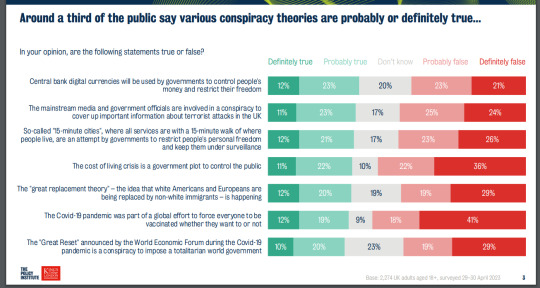
This one is from The Policy Institute of King's College London.
Statement 1: "Central bank digital currencies will be used by governments to control people's money and restrict their freedom"
One-third of people think this is definitely or probably true. The talking heads sneeringly and contemptuously imply it is false, and a conspiracy theory. The one-third of people are entirely correct. The statement is plainly true. Central banks are already used by governments to control people's money and restrict their freedom, there is no reason to believe governments will do an about-face when given a technical advance that provides more control.
For the forty percent of normies who think it's false, I imagine that most of them skimmed the question and heard something like "Government bad with money? true or false".
For the people at The Policy Institute, I think a permanent ban from public communication is in order. The misinformation is once again coming from inside the God-damned house of the professional informationists and the academic-industrial complex.
Statement 2: "The mainstream media and government officials are involved in a conspiracy to cover up important information about terrorist attacks in the UK"
This is plausible. A few years ago, I observed that the mainstream media and government officials had been involved in a conspiracy to cover up important information about gang rapes and slave rings in the UK.
Rotherham is the headline name here, where Pakistani rapist-slavers went around kidnapping, raping, enslaving, and trafficking white English girls, and the white victims were targeted partly because they were white and had less ethnic solidarity and less government protection, while the media told themselves "we don't want to cause a racist backlash" and downplayed the story partly because the offenders were brown. There were lots of cases similar to Rotherham across the UK.
Now, since the statement posits a coverup, it's hard to know with certainty. It's probably true, but I don't know. Anyone answering definitely false is wrong, though. Gullibility points for you, sir! And the people at The Policy Institute sneering 'conspiracy theory' again - the term is hardly more than a slur - I suggest punitive damages in the manner of Xerxes. Ask them how they want misinformers to be punished in a thinly veiled hypothetical of their own situation, then do that to them.
I don't know about 15-minute cities, so I'll skip ahead.
Statement 5: "The "great replacement theory" – the idea that white Americans and Europeans are being replaced by non-white immigrants – is happening"
This statement seems to load a lot on unstated connotations and other definitions of great replacement theory that the polled people won't necessarily have access to. For the summary definition given here, it appears to be true.
White Americans and Europeans have below-replacement fertility rates while their rulers are importing millions of non-whites and seek to import millions more non-whites. This is a deliberate if shortsighted government decision to keep the total population up (allegedly for purposes such as paying pensions) by importation of foreigners instead of by reversing the native decline.
How much difference between this and statement 5 is there, without having to lean on "not what I meant"?
Fuck'em.
Statement 6: "The Covid-19 pandemic was part of a global effort to force everyone to be vaccinated whether they want to or not"
Whomigonna believe, The Policy Institute or my lying eyes?
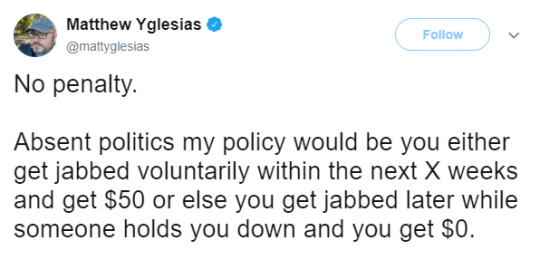
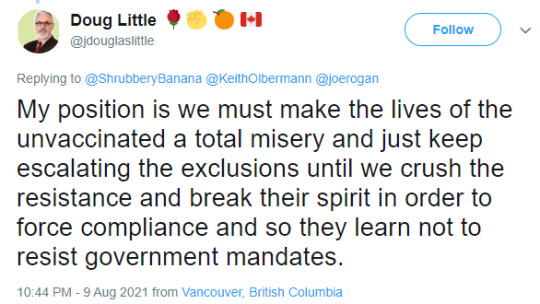
There was a global effort to force everyone to be vaccinated whether they want to or not, caused by COVID-19. It was an unpopular minority effort and it failed, but there was an effort.
The statement as given in The Policy Institute's own material is true.
Perhaps the Institutionals have an implicit mental reservation about "a majority effort" or "an effort backed by the UN Security Council" or "an effort that nearly succeeded" or some other clause that makes it false. But there's no such clause in the statement as given. The statement as given is true. It is not a conspiracy theory.
I despise these people.
Out of seven so-called [*waggles fingers aggressively*] “conspiracy theories” three are true, one is plausible, and I am exerting mental effort not to update towards the other three because reversed stupidity is not intelligence.
But I gotta say, I have more sympathy now for believers in everything listed and every other “conspiracy” they come across, because reversed malevolence is better aligned than reversed stupidity, and I can see how malevolence might compete with stupidity as an explanation for people at King's College behaving this way.
#all#rectification of names#journalism delenda est#the death of expertise#or perhaps the death of credentialism#rant#damn lies and statistics#longpost
24 notes
·
View notes
Text
Rottmnt things:
Trigger warning for real life events affecting a fictional world.
2020. The year the world was invaded by an alien race. The start of the end of the world. The year the Rottmnt movie takes place (despite its release in 2022). Irl, 2020 was a big year as well.
Covid. Covid-19 hit hard and caused a worldwide pandemic. Now imagine if Covid also affected the rise verse. On top of an Alien invasion, which would take precedence, there’s this virus roaming around. There is no government, hospitals are shutting down, society is collapsing, people are spread out but those who find each other stay together. Close. It’s the best way to survive and the best way for a virus to cultivate.
Covid-19 primarily targeted the older generation, those above 50 and has devastating lasting consequences if you managed to survive. But the apocalypse is THE WORST time to get sick, and with resources dwindling, there would be no attention toward a vaccine, limited amounts of ventilators or materials to actually help if someone got sick. You’d be doomed. And the best way to help would be isolation, not to spread or contaminate. And bam. There goes the older generation, the experienced old men who might’ve fought wars before, who could’ve trained, or brought different kinds of survival instincts to the war effort. Any young adults or teenagers affected by the disease might have lasting consequences that affect how much they can help fight. That shortness of breath would really get to you in a world where you have to stay on the move, or fight for your life, or just having to breath in the hot, dusty air around.
The older generation gets wiped out not just from Krang, but from Covid, leaving the resistance to fall into the hands of children.
Wether or not Splinter might’ve been affected, I’ll leave up to you. He fits the target age range, but his rat genes may effect how the disease affects him, if he gets it at all.
But Covid is skepticism, since it’s a fictional world with mutants. Who even knows if it happened, or even if it was worse.
But there’s another thing. Once again, related to the older/middle generation. 9/11. About a week ago, and maybe it’s still going on, fires in Canada caused thick smoke to fall on New York City. An amount which hadn’t been seen since September 11, 2001. Seeing the pictures from my dad, who was traveling in NYC during this time, it gave very apocalyptic vibes and I myself was inspired to give that atmosphere to Rise.
However, there is another connection. The tallest building in New York. The building The Krang attacked, called Metro Tower in the movie, is the World Trade Center. The building that was set as a replacement for the loss of the twin towers. As a reminder that America is still strong and will not forget, by happenstance is the place the Krang enter from the prison dimension, bringing forth terror and destruction.
Anyone in New York who lived through that, and now through this could be prone to PTSD. The sky, the atmosphere, everything could be effected by the krang attack. The lasting effects to the environment as well, and very likely, worse.
9/11 is likely the reason the name of the building was changed to Metro Tower in the movie. Or, you can take that with a grain of salt.
Of course neither of these things HAVE to have any lasting affect. There is so many other things going on that these may seem insignificant. But I think it’s interesting to imagine, and possibly interesting to add.
#rottmnt#wabbystuffpost#rise of the teenage mutant ninja turtles#tmnt#tw: real life#history effects storytelling#apocalyptic future#it’s the apocalypse but we can still have fun#fanfiction#inspiration#TMNT analysis#but that’s just a theory#analysis#long post#rottmnt bad timeline#real life and fiction#Covid is suddenly not the worst thing that could’ve happened#important events in our lives take the back seat in theirs#food for thought#yum yum#rise of the tmnt
13 notes
·
View notes
Text
How to Ignore More than a Century Worth of Scientific Literature and Make Headline-Grabbing Claims on One of the Deadliest and Exhaustively Studied Pandemics in History Based on Flawed Data and Questionable Analysis
The 1918 influenza pandemic, also erroneously referred to as the “Spanish flu,” has affected up to one billion people—half the world’s population at the time—and has killed an estimated 20–30 million people in the Western World and God-only-knows-how-many people in other countries. Previous and subsequent influenza pandemics usually hit infants and the elderly the hardest. The 1918 influenza pandemic was a weird one because of the atypically high mortality among young adults. The peak mortality rate during the fall wave of the 1918 influenza pandemic in Canada and the USA was 28 years. The death of young adults lowered the average life expectancy in the United States by more than 10 years. Numerous studies have confirmed these findings.
A typical picture illustrating the haunting age peculiarity of this pandemic is shown below.
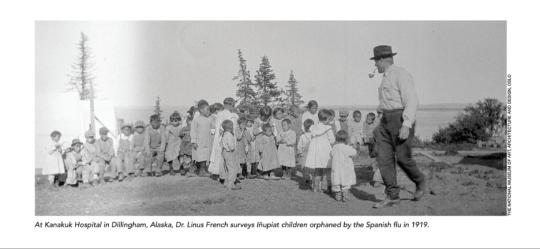
Even in poor, medically underserved communities, it was the young healthy adults that perished leaving many very young orphans behind.
In the early 2000s scientists started looking for samples of the 1918 virus. They reasoned that their best chance was to find it inside an influenza victim buried in permafrost. Brevig Mission in Alaska had 89 inhabitants in 1918 of which 87 died of influenza. It was a good bet that some sequenceable genetic material could be recovered from the graves of these flu victims. Indeed, genomic RNA of the 1918 virus was recovered from frozen lung tissues of an Alaskan influenza victim who was buried in permafrost in November of 1918.
In 2005, scientists used reverse genetics to generate an influenza virus bearing all eight genome segments of the 1918 virus to study its properties. The deadly 1918 virus has thus been resurrected!
The reconstructed virus turned out to be as deadly as the original one with a 100% mortality in mice. Another conclusion of this “resurrection” study was that the virus kills by overreaction of the body’s immune system, which explained the weird age distribution of deaths due to the "Spanish Flu." The strong adaptive immune systems of young adults ravaged their body, whereas the underdeveloped immune systems of young children and the weakened immune system of old people resulted fewer deaths. It was inflammation that killed people, not the viral infection directly or secondary infections. These studies seemed like the end of the 1918 influenza story.
Imagine my surprise, then, when at the end of 2023, I started noticing that the 1918 influenza pandemic is in the news again. “Killer 1918 flu didn't pick on the healthy, after all,” declared Science (the same Science that “killed” Junk DNA a decade earlier). “History Says the 1918 Flu Killed the Young and Healthy. These Bones Say Otherwise,” quipped WIRED. And US News and World Reports headlined the findings as “Contrary to Popular Belief, 1918 Flu Did Not Target the Healthy Young.”
The origin of these headlines was a 2023 paper in Proceedings of the National Academy of Science entitled “Frailty and Survival in the 1918 Influenza Pandemic” by Amanda Wissler, currently an Assistant Professor of Anthropology at McMaster University in Hamilton, Ontario and Sharon DeWitte, Professor of Anthropology at University of Colorado in Boulder. The paper was largely based largely on Wissler’s PhD dissertation at Arizona State University under the supervision of Professor Jane Buikstra.
One would have thought that a study that purports to discard more than a hundred years of observations, refute dozens of analyses, refute the conclusions in about 18,000 peer-reviewed articles, and generate headlines in serious news media would require a great amount of unimpeachable data and an analysis that is—if not infallible—close to infallible. If you thought that, you will be sorely disappointed.
Let us start with the Materials and Methods section. The study is based on a bone sample from the Hamann-Todd Osteological Collection which contains skeletons of people who died in Cleveland, Ohio between 1910 and 1939. The skeletons belong to people whose bodies were not claimed within 36 hours of death (i.e., the poor, the homeless, the socially isolated, the incarcerated, the institutionalized as “mentally defectives,” and those whose relatives couldn’t possibly collect their loved ones’ bodies within a day and a half. Black and indigenous people most probably made the bulk of this collection. Wissler and DeWitte euphemistically called their sample as consisting of “individuals of low socioeconomic status,” who mostly “died in almshouses or public hospitals.” Is this sample representative of the population in Cleveland between 1910 and 1939? I very much doubt it. And don’t even start me on the ethical crimes committed to assemble this collection. Of course, the bodies in this collection were legally obtained following an Ohio legislation that permitted people whose bodies were not claimed within 36 hours of death to be “donated” for scientific study, but was the collection ethically assembled? I think not! The ethics of this collection reminds me of a joke my dad used to tell. “A religious Jewish woman goes to the Rabbi in a panic. ‘Rabbi, the chicken I cooked for Shabbat dinner fell into a soiled baby's diaper. Is it still kosher?’ she asks. The Rabbi replies, ‘It's kosher, of course, but I would I eat it?’” But, I digress.
Wissler and DeWitte’s sample consisted of 369 individuals: 310 males (84%) and 59 females (16%). This fact immediately tells the reader that something is off; the sample is not representative of the general population.
Curiously, the Materials and Methods section also contains the following statement, “to maximize the sample size, both the 1918 flu and the control groups include individuals who died from influenza and pneumonia as well as other diseases such as tuberculosis and myocarditis.” (No data is provided as to how many individuals were included for the purpose of padding the sample size.) Finally, medical history for the individuals in the study is mostly not known. Thus, it is impossible to know whether “an individual suffered another disease during life unless it was listed as the cause of death or left diagnostic evidence on their skeleton.”
Finally, we have the problem of missing data. In the previous paragraph, we have seen one method of padding the data. Here comes another one. The last sentence of the Analytical Methods section states that missing skeletal data “were imputed using the ‘pmm’ function of the mice R package following previous recommendations.” Now, I need to tell the reader that I get hives and homicidal thoughts whenever I read the terms “imputed” or “imputation,” which nowadays essentially mean conjuring data out of thin air. Interestingly, “imputed” was originally a theological term meaning to falsely ascribe guilt to a person. The way data analysts use the word “imputed” started with economists in 1893 when a step in a multistep process was assigned a value by inference from the value of the process to which it contributes. More recently, the term “impute” was used by the Internal Revenue Service to assign interest to an investment when the interest rate is not known. The fact that imputation is used in scientific research to artificially increase the sample size is an inexcusable obscenity.
In the abstract of the article, it is stated that “frail or unhealthy individuals were more likely to die during the pandemic than those who were not frail.” Now, “frailty” is a nebulous and inexact term often defined as “an aging-related syndrome of physiological decline, characterized by marked vulnerability to adverse health outcomes.” https://www.uptodate.com/contents/frailty Thus, the authors used a skeletal proxy to identify frailty. The proxy was lesions on the shinbones (periostosis). Whether this proxy has anything to do with anything is unknown.
The choice of lesions on the shinbones reminds me on of the Streetlight effect or the Drunkard's search principle—both examples of an observational bias whereby one limits the variables used in a study to those that are easy to obtain regardless of whether the choice is actually relevant to the study question.
Let us now discuss the article’s statistical analyses, results, and conclusions. A good piece of advice that I once got from one of my mentors was “Before you subject your data to complicated analyses and reach extravagant conclusions, do yourself a favor and look at the data carefully and perform some simple analyses.” In this case, subjecting the data to complicated (and frankly confusing) Kaplan–Meier survival analysis, Cox proportional hazards analysis, and Schoenfeld test, one should look at the data and do some long division or at most some simple 2×2 contingency analyses.
The following data was extracted from Table 1 of Wissler and DeWitte (2023).
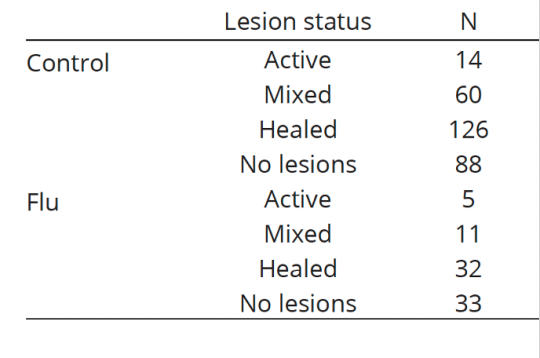
The first thing I noticed was that 67% of the skeletons in the sample belonged to "frail" people. Does this look like a representative sample of the population of Cleveland, Ohio in 1918? The second thing I noticed is that 69% of the control group have had lesions on their shinbones (either active or healed) versus 59% in the group that succumbed to flu. Thus, by the definition used by Wissler and DeWitte, the group of people that succumbed to influenza were 14–17% less “frail” than the group that survived. Of course, in my simple analysis I can use the skeletons exhibiting active or mixed lesions versus the rest of the skeletons (healed and no lesions). In this case, 25% of the control group turn out to be frail, versus 20% in those that succumbed to flu. This result seemed to support the thesis of Wissler and DeWitte, until you realize that the difference is not statistically significant (Fisher's exact test, P = 0.3074).
After reading this paper very carefully, I am left with one open question. It remains unclear to me how this paper managed to get published in PNAS and become a news sensation. Is this another example of the power of the press release?
2 notes
·
View notes
Text
‘For Your Convenience’ (Short Film) #StopAsianHate
Director - Aronjonel Villafor

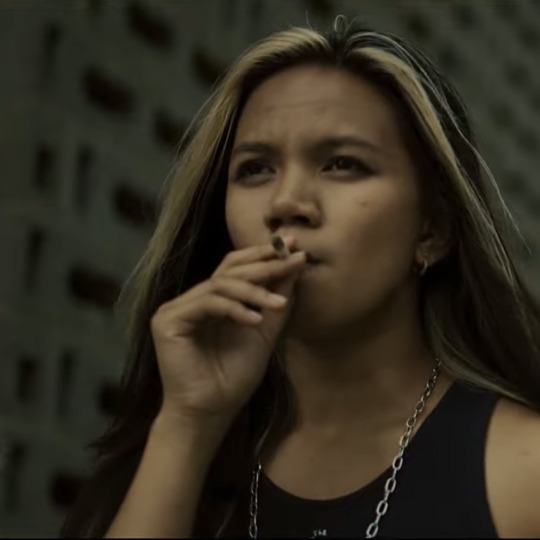
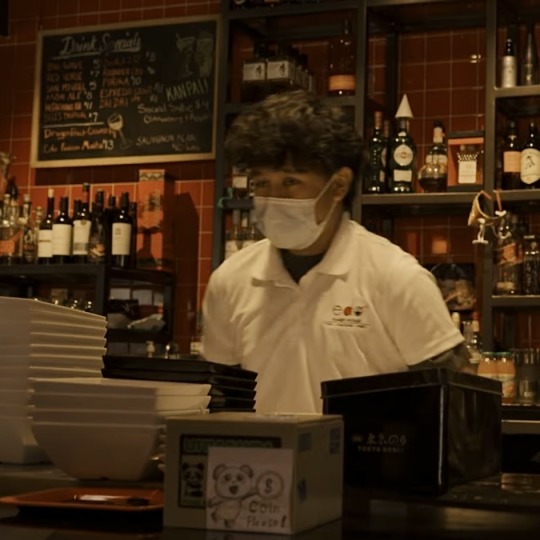

I watched this short film where I found Valladolid doing a great job portraying what life was like for Asian Americans during the pandemic.Within this film it shows the day to day reality, Asians had to face during the coronavirus. They go to work just so they can support themselves,not only is it hard already with how covid changed everything but they also have to deal with seeing people of their own race getting attacked and robbed in public,I can imagine that you constantly have to look over your shoulder because we did not feel safe since Asian people are the prime targets for theses violent attacks.
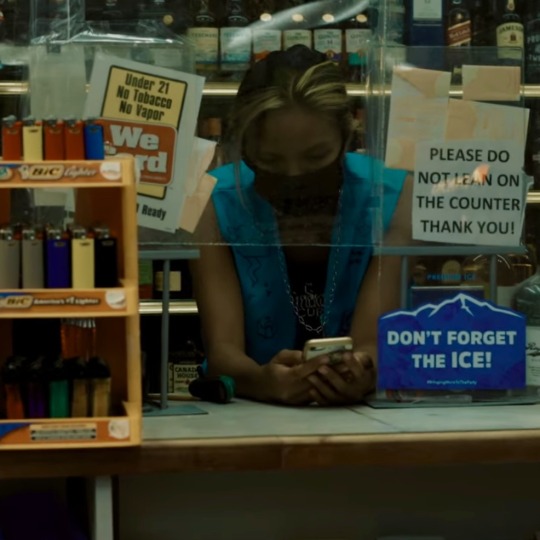
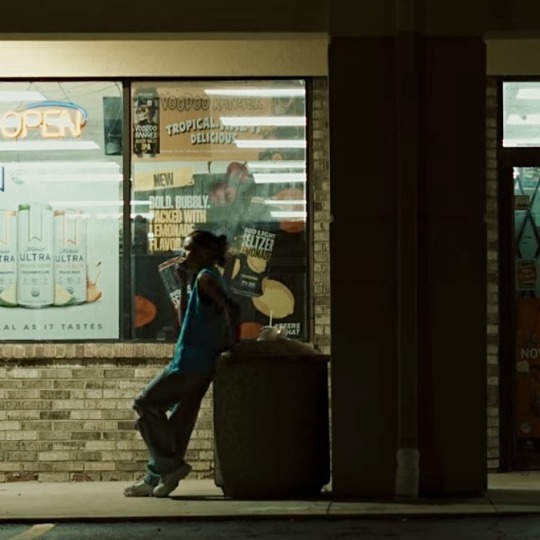
You can imagine that in the film that she’s exhausted. Not only is she having to work to support herself but with these strikes going on it’s getting hard for her to have to deal with hatred where people blame you for the cause of the pandemic.Theres a point in the film where a violent woman refuses to where a mask and begins to act hostile with the worker and starts blaming her why we have to where masks during the “Ching Chong Virus” and further gets violent by throwing products on the ground and yelling “go back to your country”.
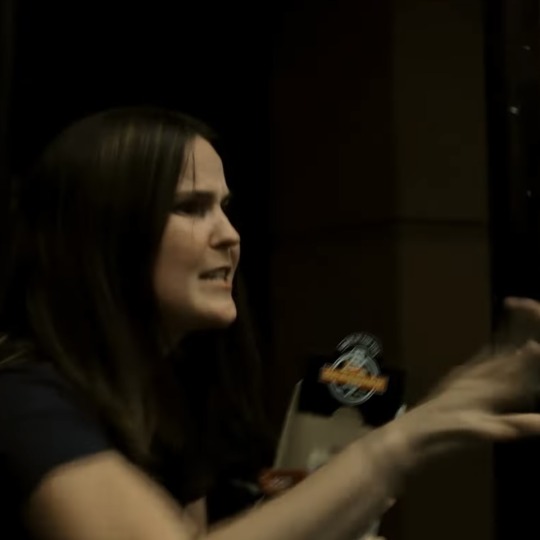
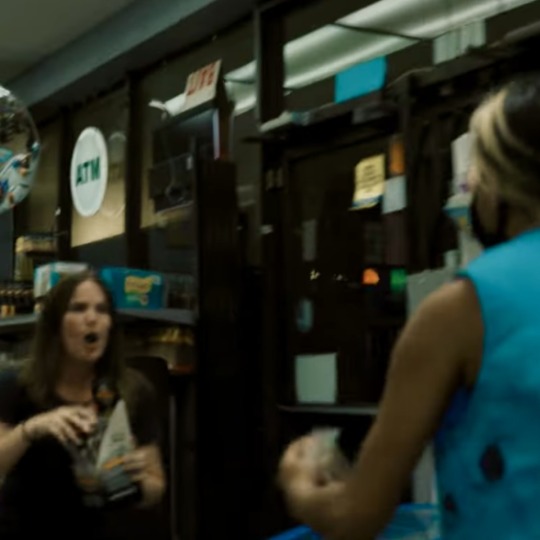

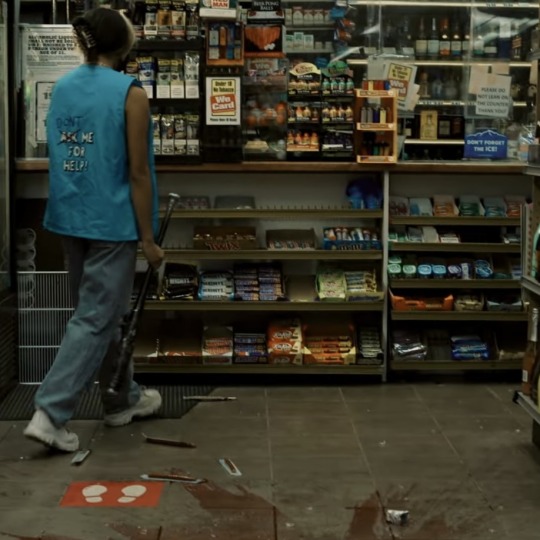
Reason why i chose this short film is because i really like how that in this film conveys the reality of what it was like for the majority of Asian people during the pandemic and i take inspiration by showing the abuse and movements that AAPI had. I want to show the importance of Asian peoples stories during this difficult time and how it impacted us. I can understand it affected many people across the globe but when your looking over your shoulder constantly by making sure you dont get violently attacked you can’t help but deny what Asian People had to go through and and the director Aronjonel Villafor succeeded in showing the viewer what really was like for us.
6 notes
·
View notes
Text
FILIPINO PANDEMIC ADVERTISEMENTS
youtube
Advertisement #1: Basta (RC Cola advertisement)
The first video advertisement that I chose was a video advertisement of RC soft drink. A 2020 television campaign for RC Cola in the Philippines was made by the ad firm Gigil and is titled Basta ("Whatever"). It was initially made available online in November 2020. The idea was that a tormented youngster would come home from school and ask his mother whether he was adopted. The son takes off his backpack as tears fall down his cheeks and four glasses appear to be sprouting from his back. Before removing her own head to admit that she is actually a huge bottle of RC Cola, the mother laments, "We've kept this secret from you for so long." The commercial concludes with the mother putting cola in the glasses from her neck and the family using straws to drink from the boy's back. Local families are the target market for this advertisement, which clearly depicts them eating together and sharing a meal. It also depicts Generation Z and their reactions toward modern problems in society as dramatic humor. The advertisement demonstrates that RC helps people in times of adversity pain and distress by helping them bond together. This is shown especially in the confrontation segment of the commercial when the mother pours drinks and drinks with the whole family while smoothing out the issue of his adoption and the whole family not telling about it. The advertising itself wasn't necessarily horrible because it was able to serve comical relief and transform what was meant to be a tragic series of events into something original and creative. The product however was also not necessarily bad but may not bring health benefits while drinking too much would add health complications. The advertisement does not appear to have any media manipulation thou heavily suggests drinking RC, especially at meal times. The advertisement solely focuses on being creative as to gather as much attention as possible while being low on budget. The work was inspired by current Generation Z humor and passion for things that are ridiculous as shown by the four glasses on the back of his body and the mother turning into an RC bottle emphasizing on the level of craziness of the situation.
------------------------------------------------------------------------------
youtube
Advertisement #2: A Message from the Future (Jollibee)
The Jollibee commercial "A Message from the Future" is the second video advertisement that I have selected. The most popular fast-food chain in the Philippines is Jollibee, and chicken is one of its primary selling points. The television commercial "a message from the Future" asks viewers to imagine themselves in the future and depicts the epidemic from that point of view. The world is described in the advertising as being "painful, scary, and upended lives around the world". The advertisement focuses on the tale of a Filipino immigrant family living in New York City that, like millions of other people worldwide, has suffered greatly as a result of the epidemic. The ad depicts the numerous pandemic repercussions, including job loss, loved ones passing away from the virus, and the mother of the family contracting the disease. Jollibee emphasizes the value of family unity while pointing out that despite all of these losses, the family has managed to find pleasure and love in their suffering. Our family was what carried us through everything, from literally spending every waking hour together in lockdown to extensive video chats across countries. Finally, the grandpa advises her granddaughter to "never take anything for granted" as the campaign comes to a close. The products of Jollibee itself were not necessarily good or bad as the product is food. However, as mentioned it is a product of a fast food chain which means it has many calories as well as fatty foods which may be bad for the health if eaten every day or frequently. The advertisement itself does not contain any malicious or misleading content and does not manipulate a common truth about what happened during the pandemic. However, the advertisement focuses on human perseverance and determination as a whole. In addition, the campaign signifies the transition of fear into hope by the color grading of the film from monochrome black to a colored one. The ad relates to each and every one of us that has experienced the pandemic and experience its horrors which is what the ad used to capture the attention of the audience
______________________________________________________________
References:
Contagious. (2021, July 20). The strategy behind RC Cola's basta campaign in the Philippines. Contagious. Retrieved from https://www.contagious.com/news-and-views/insight-and-strategy-behind-rc-cola-Filipino-advertising-campaign
Cambosa, T. (2021, May 19). Jollibee's first-ever global campaign a 'message from the future' on finding Joy over fear. MARKETECH APAC. Retrieved from https://marketech-apac.com/jollibees-first-ever-global-campaign-a-message-from-the-future-on-finding-joy-over-fear/
2 notes
·
View notes
Text
... I was rolling my eyes and throwing together a list of basic shit you prep for according to your local emergency measures, and then I realized that I've been basically insulated from climate disaster since I moved from Texas to Minnesota. Wild.
This is not a statement on whether people should move, by the way. This is a reminder to think about the human toll in places trapped under "red" state authorities, which will be far less able or inclined to provide shields against abusive federal orders. It is both good neighbors and good politics to look after things like local DSA chapters to coordinate direct action and community repair, and that will probably be a piece of the dynamic in coming years.
Anyway, here are things that occurred immediately to me as likely effects of the current actions of the incumbent federal administration, based on things I've lived through and expect to live through.
several "boil water" notices, which happen if your water treatment can't be certified as safe to drink without boiling: what will you do if your water gets contaminated?
I lived in Texas through Snowpocalypse 2021, when many people lost power and basic utilities like water were disrupted in the middle of a climate emergency storm, with active pandemic raging and no vaccine available. Imagine
What will you do if you experience a really bad storm/flood/tornado/wildfire and you can't rely on government resources for things like storm monitoring, accurate disease tracking, water safety, etc.? Your plan should involve your community; for example, we transported pre-boiled water for friends whose water didn't work.
The NOAA is currently being dismantled. What are the odds that your community is going to get hit with a storm or a weather front that you currently rely on NOAA data to dismiss? (Everyone relies on NOAA data.) How else can you predict those climate change induced storms?
Currently, we have a pretty aggressive measles epidemic ripping throughout much of the US. Do you know how to protect yourself and keep yourself as safe as possible from a measles outbreak? Hint: it looks different from COVID because measles is just so goddamn infective. Measles is a pain in the ass of a disease. Sure, it mostly won't kill kids if they get it early, but it wreaks havoc on the immune system in ways we are only now beginning to understand. Children have died. So: what's your vaccine status? What is the status of your community? Can you protect the vulnerable among you? What are you going to do if measles hits the community and employers start whining about quarantine rates or back to work mandates?
It is important to think about these threats in terms of specific things that people might announce or attempt to implement, because that helps you plan specifically for your area's situation. If you don't know what that is, awesome! There's your first step. Start there.
If there is an immediate threat to you, it will come as a product of the overall risk and your particular circumstances. Politically, do you know who your chief of police is? How have they handled similar events in the past? How much experience do they have (less is probably better)? How about your sheriff, if you have one?
If there is going to be some kind of purge, it is extremely likely that those sorts of people are going to be the determining factor regarding whether it gets carried out. You will want to know what kind of person you have in the helm and what their record is on people like you as you think about your plan, yes? Is there anyone else they might target first? How would you know, and what would you do?
That's what it means to be aware of the potential catastrophic collapse of the federal administration: some of the public services that our feds perform are incredibly important things like "preventing infectious disease epidemics like COVID, which only happened the first time because Donald Trump gutted the CDC". If they are not available, if for example we no longer have weather information from the NOAA to work with, what are we going to do about that critically load bearing pillar suddenly gone from the most basic everyday functions?
I mean, show up to the local Tesla dealership and maybe harass Tesla drivers about it too, obviously. But there's shorter term stuff to figure out too, and that's way more practical than fretting about your damn bug out bag.
Been seeing a lot of folks talk about bugout bags where the context seems to be fleeing a Knock from secret police or something, and I want to gently suggest folks consider more likely reasons to bug out (wildfires, crumbling infrastructure leading to gas leaks, etc).
Make sure your bag can get you through scenarios where you are part of a mass evacuation, rather than you clandestinely leaving in the middle of the night to escape brownshirts.
I feel like thinking in this context will help folks prepare better and think beyond fleeing to the nearest border as their prime objective.
I don't like giving this regime more power than it actually has, so it is helpful to me to think about what I would do in specific scenarios. Planning for those gives me much more concrete action items, reduces my panic, and ends up preparing me better for unknown situations.
A lot of us have real fear of this regime rn, and escaping a Knock is a realistic concern.
But I feel like a lot of white, cishet, middle class folks are in oppression cosplay mode rn, and their brains aren't in a practical space for what the more likely impact to their lives is going to be.
If preparing for a Knock isn't also going to prepare you for facing sitting in traffic for 12 hours with no hotel plans because you need to evacuate a natural disaster on short notice, you should think a bit more about your risk factors and resiliency.
Vague prepping for "When shit hits the fan" means you are going to forget key items. Come up with some specific scenarios to run through and see how your kit would perform.
#honestly the most terrifying things for me are things like food access and shit#seriously considering moving out of the city for more yard and garden access.#but fuck knows what will happen with no cpa#us politics
5K notes
·
View notes
Text
The Morning Briefing: I Don't Want to Be Greedy, but Can We Get Some COVID Comeuppance Now?

Top O' the Briefing
Happy Thursday, dear Kruiser Morning Briefing friends. Shezwald felt happiest when other restaurant-goers supported his choice of a third patty melt.
Look, I know that things are going very well these days for those of us over here on the right side of the political aisle. President Trump and his merry band of anti-Swampers have been hitting one home run after another since lunchtime on January 20. Heck, now that the dismantling of the Department of Education is underway, I should be so thrilled that I don't care what happens going forward.
People all around me have been writing and talking about the five-year anniversary of the onset of the COVID nightmare back in 2020. Thinking about all of that is something that I try not to do. I'm very good at compartmentalizing and I like to keep the COVID-19 dark stuff locked up in a place where my conscious or subconscious aren't likely to stumble upon it. The remembrances of others these past couple of weeks have, unfortunately, unlocked the COVID compartment.
Rick wrote a VIP post the other day detailing why he thinks a pandemic "reckoning" is in order. I couldn't agree more. We would all like that, I'm sure, even though we may differ on how to go about it.
After reading my partner in thought crime Stephen Green's column reminding us of the COVID celebrity lockdown serenade I might be advocating for harsher punishment for the tyrants. Quoth the VodkaPundit:
It's said that nothing is as bad as what you can imagine. Except, of course, for John Lennon's "Imagine." Particularly when it's sung as a series of treacly solos by well-meaning (???) celebrities trying to make us little people feel better about being locked in our homes, and having our jobs, businesses, schools, playgrounds, and access to dying Nana in the nursing home all taken away.
Look, on my best days just hearing "Imagine" makes me get in touch with parts of my psyche that weird me out a little. It's truly one of the most hideous famous songs in the history of music. Stephen has more on that in his column. Recalling the lockdown celebrity singalong cover of "Imagine" really triggered my desire for retribution. I wouldn't be surprised if one day people are allowed to plead "Imagine" in court and get away with all sorts of things.
The Trump administration is doing a good job of cleaning out the tyrannical riffraff from the federal bureaucracy. Better yet, he's replacing them with some people who were blackballed for telling the truth in 2020. This is from Catherine:
The Senate confirmed Dr. Jay Bhattacharya as director of the National Institutes of Health on Tuesday, a victory for honest science versus corrupt, biased pseudo-science at the federal level. The COVID-19 lockdowns and other government policies that the NIH pushed under previous leadership were disastrous, which is why top NIH officials Francis Collins and Anthony Fauci were so desperate to censor free speech revolving around their terrible policies. One of the targets of tech-government censorship collusion during lockdowns was Bhattacharya, as the Twitter Files showed. But now that the tables have turned and the Trump administration has put the censored doctor in charge at NIH, the agency will hopefully no longer prioritize authoritarian government power over the scientific method.
That is a bit of sweet revenge, I suppose. Let's be honest though, we're all hoping that the key government players from the pandemic to get their due. Seeing Anthony Fauci perp-walked and outfitted in an orange jumpsuit is the dream, isn't it? If President Trump's undoing of Joe Biden's autopen preemptive pardons works out we may get to see that.
Fauci insisted that he didn't need a pardon for anything, but evil people never view themselves as evil. I'm sure Adolf Hitler fancied himself as a sparkling wit who was delightful at parties.
Consequences aren't a big part of the lives people on the Left who do awful things to others, which is galling. The worst of the COVID tyrants — Andrew Cuomo and Gretchen Whitmer come immediately to mind — have body counts for which they're not being held responsible. Cuomo lost his job because he was a sexist pig at work and he's already attempting a political comeback. All of the elderly people he sent to die in nursing homes don't seem to weigh on his conscience at all.
I'm no legal expert, so I don't know what, if anything can be done to the execrable people who held sway during the pandemic. I just know that complete societal breaking is just around the corner if people who abuse their power to ruin the lives of others keep getting away with it.
0 notes
Text
[Week 10] The Internet: Digital utopia or cyber hell?
I know you’re probably tired of my long-winded, trying-to-be-funny introductions. So today, let’s keep it short and sweet!
Social media has revolutionized the way we communicate: faster, more convenient, and way more creative. (Seriously, who knew we’d be expressing emotions through GIFs and cat memes?)
But with great technology comes… well, new problems. And unfortunately, that includes a scarier, more powerful form of bullying. Imagine an embarrassing photo of you going viral, spreading across platforms at lightning speed for the world to see. Yikes.

So, dear readers, today we embark on one last adventure: Social Media Governance and Cyberbullying. Buckle up!
What is Social Media Governance?
Social media governance goes beyond just policies and regulations, it covers everything that shapes how we communicate online, from legal frameworks like copyright and freedom of expression to platform-specific rules (Flew, 2015).
In simple terms, it’s the system of rules and policies set by both governments and private institutions to regulate social media. This governance isn’t just about strict laws, it also includes informal guidelines, like community rules in Facebook groups. Plus, these regulations can vary from country to country, meaning what’s acceptable in one place might be restricted in another.
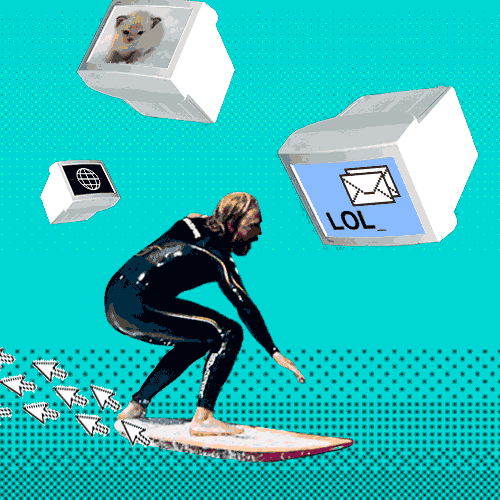
At its core, social media governance is all about who controls and manages digital spaces and what rules shape our online interactions.
Cyberbullying: The Shadows that follow you online
46% of U.S. teens aged 13 to 17 have experienced cyberbullying at some point. (Pew Research Center, 2022)
The rise of the internet has given way to a major issue: cyberbullying, the act of harming others through digital platforms. With technology’s reach, it’s more relentless than ever. Here’s how it happens:
😦 Insults: Degrading comments, body shaming, and threats in posts or messages.
😦 Embarrassing Media: Private photos/videos shared without consent or recordings of real-life bullying.
😦 Harassment & Rumors: Sexual harassment or false rumors spread to damage reputations.
Cyberbullying has led to many heartbreaking stories, one of the most tragic being Amanda Todd’s case in 2012. Amanda, a Canadian teen, was targeted by an online predator who blackmailed her with sensitive images. When she ignored him, he spread the photos online, ruining her reputation and making her a target for relentless bullying. Despite changing schools, the harassment followed her, leaving her isolated and distressed. In October 2012, after sharing her painful story in a YouTube video, Amanda tragically took her own life.
youtube
Her case gained worldwide attention, prompting international investigations and legal reforms in multiple countries to better protect victims of cyberbullying (Butts, 2024).
A problem with no escape?
With countless suicides linked to cyberbullying since the dawn of digital spaces, you’d think platform moderators and governments would have stepped up by now. But honestly? They’re doing a terrible job. In fact, social media feels more toxic than ever. Although they introduced new laws against online harassment, no one really takes them seriously.

Post-pandemic, people have gotten way too comfortable online. And no platform embodies this better than TikTok, the capital of toxicity. If you enjoy reading comments like I do, you’ll find hate lurking under everything. Cute pet video? “You’re a terrible owner.” Someone eating? “Damn, you must be built like a bus driver.” And let’s not forget the art of turning someone’s happy moment into viral mockery.
Now, I won’t entirely blame moderators (though they should be way more aggressive). There are just too many users to manage, and even if trolls get suspended, they just make new accounts and keep going. Governments have tried limiting young users to shield them from harmful content, but let’s be real, kids just fake their age. Meanwhile, hateful content sneaks by under the guise of “personal opinion” or “constructive criticism.”
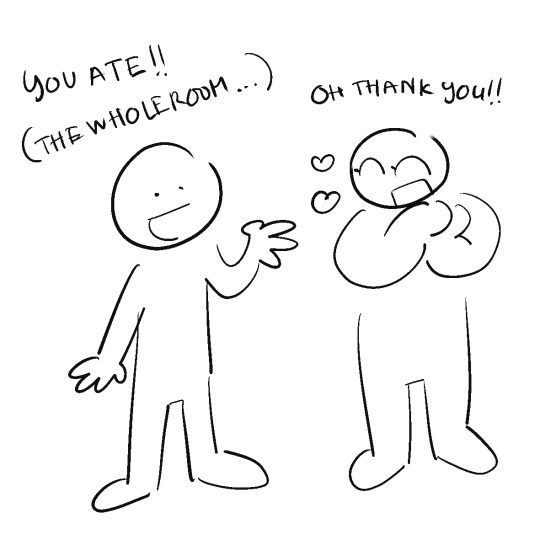
(With internet slang evolving at light speed, insults have become an art form. No wonder these people dodge bans like it’s a side quest.)
So yeah, the system is failing, and the internet is a mess. Sigh.
Quick fixes for now, real change needed
What should you do if you're being cyberbullied? Unfortunately, there’s no guaranteed way to avoid online harassment, bullies always find a way. But here’s what you can do: report them, block them, and if your country has laws against online harassment, take legal action. Most importantly, don’t let their words get to you. Stay strong and remember, what they say reflects them, not you. Also, be cautious about what you share online, and always think twice before posting anything personal so it won't be used against you.
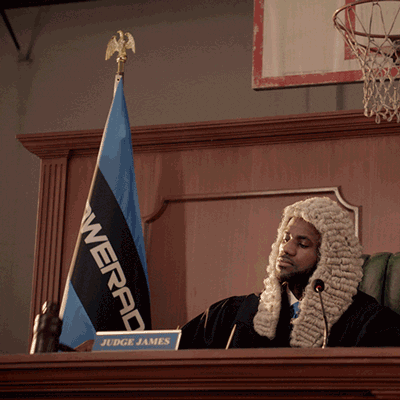
As for solutions? Governments need to step up. No mercy for actions that can destroy lives. The only thing these people fear is real punishment—jail time or financial penalties that actually sting, like losing half a year’s worth of living expenses.
That’s all from me. Stay safe online, and thanks for reading!
References:
Atske, S. (2022, December 15). Teens and Cyberbullying 2022. Pew Research Center. https://www.pewresearch.org/internet/2022/12/15/teens-and-cyberbullying-2022/?utm_source=chatgpt.com
Butts, E. (2024, May 10). Amanda Todd Case. Www.thecanadianencyclopedia.ca. https://www.thecanadianencyclopedia.ca/en/article/amanda-todd-case
Flew, T. (2015). Social Media Governance. Social Media + Society, 1(1), 205630511557813. https://doi.org/10.1177/2056305115578136
0 notes
Text
Viasat Satellite Attack: Should I Be Worried About my Satellite Internet?
The Internet: love it or hate it, we all use it.
Well internet is a necessity these days, arguably on par with water or electricity. Imagine enduring the pandemic without the internet—no access to education, work, social engagement, government, the economy, etc. Internet access fuels social and economic life, and the the lack of internet leads to social and economic exclusion and inequities (aka the digital divide [1]). Thus, for harder-to-reach areas like rural, remote, and disaster [2] locations—where traditional cable or fire optic internet is unavailable—people often rely on the more expensive satellite internet. Good, right?
Unfortunately, recent events show satellite communication systems are vulnerable:
June 2023: cyberattack on Dozor-Teleport, a Russian satellite communication system [3].
February 2022: political cyberattack on Viasat (satellite internet provider) disrupting service for over 40,000 Ukrainian/European users
So, how is this possible? What does it take to bring down telecommunication systems for tens of thousands of users? And what does this mean for me?
Note: Referencing the Viasat case throughout this article, to answer these questions.
How Does My Satellite Internet Work?
Satellite internet is comprised of four parts: the provider, satellite, modem, and end-user. Reference this diagram.
Internet Service Provider (ISP): This is the company giving you access to the internet. They transmit and receive signals from satellites with large dish antennas.
Internet Satellites: Internet satellites can orbit in either the geostationary orbit (GEO) the or low Earth orbit (LEO). GEO satellites (e.g. Viasat’s KA-SAT) remain fixed with respect to a specific location on Earth, and cover larger areas. However, they are further away, which means higher latency. In contrast, LEO satellites (e.g. Starlink) exist. They are magnitudes closer, which means lower latency. However, this also means their coverage is smaller, and it is not fixed to a specific region on Earth. [distance diagram]
Modem: This is the hardware component, typically attached to the side of your home. They bridge you to the satellite/internet.
Satellites Seem Kind of Far, How are They Attacked?
“To disrupt satellite communications, most people—myself included—would look at the signal in space, because it's exposed. You can transmit signals toward the satellite that would effectively jam its ability to receive signals from legitimate modems” [4]
- Peter Lemme, subject matter expert
First off, how was the Viasat's KA-SAT satellite attacked? This was a two-part attack focused on the modems, not the signal.
Network Jamming: The traditional and expected part was jamming the network. Hackers flooded servers with over 100,000 requests in a 5-minute window. This overwhelmed the network and prevented modems from being able to connect and make requests to the network, thus disrupting internet services.
Malware - AcidRain: The second—and more unexpected—part of this attack was deploying "destructive commands" targeted at Ukrainian modems. Hackers accessed the server where Ukrainian customers can download modem updates and (more importantly), where automated patches are pushed to modems. Rather than sending the typical patch, hackers deployed AcidRain: a custom designed malware. AcidRain was composed of a wiper and a script. The script calls the wiper which overwrites critical data on the modem, effectively erasing it. Upon modem reboot, the machine is permanently unable to reconnect back to the network. Top Ukrainian cyber official Victor Zhora describes hack as a "huge loss in communications" [5]. Zhora is not wrong. The aftermath of this attack forced Viasat to have to ship over 40,000 modems to affected customers to restore their internet services.
Potential Other Satellite Attacks:
The Viasat attack did not target the signal itself, as one (e.g. Peter Lemme) would expect. It did not require a signal injection, which is where the attacker (instead of the satellite) sends signals to the person's modem [6]. This disrupts communication by sending noise (jamming) or spoofed data, and brings up variety attacks:
Overshadowing - attackers signal overlaps with the legitimate signal. Attacker overwhelms the line, corrupting data transmitted over the signal, and/or generally disrupt service.
Man-in-the-Middle (MIM) - use packet capture tools to collect and inspect packets transmitted over the signal, effectively eavesdropping. These are hard to detect, because the service (e.g. internet) could be functioning as expected.
Replay - adversary resends the packet they collected. Even if they do not know the contents of the packet, this could still send noise, and disrupt service. Viasat likely attaches a timestamp or counter to the packet, to enforce packet freshness, thus preventing this attack.
Spoofing - hacker creates malicious packets to trick the endpoint into accepting forged updates or commands (requires knowledge of packet structure). Viasat likely encrypts the data transmitted, which makes spoofing unlikely, because decrypting packets is typically computationally infeasible.
These are all possible satellite communication attacks, directed towards the signal. However, Viasat's AcidRain did not attack the signal. Instead, the packets sent were completely valid because the server/ISP was compromised.
Allegedly, How Do I Defend a Satellite?
For the Viasat case, the main security recommendation lies in the security of the server/ISP. Hackers were able to use a misconfigured VPN to gain access to the server, and the escalate their privileges—subsequently accessing the management server, network operations server, FTP server[8]. As a result, they were able to deploy their "patch" to thousands of modems—an action only highly authorized employees should have the ability to do. To prevent this, a ISP should have robust policies that define system behavior, limit user's systems access, etc.
For example, ISP's should have policies to define normal behavior, in order to flag anomalies. Viasat's "patch" was deployed at 3:02 am. These are outside of Viasat's business hours, and thus a "patch" of this scale would clearly be an anomaly from standard operation, and should require external authorization or trigger some kind of alert.
In addition, the hacker did not use brute force to gain access; they had valid credentials into the VPN. Viasat did not state the attack was an inside operation, which means credentials were likely compromised without the employee’s knowledge [8].
One possibility is that in 2021, Fortinet—the company in charge of Viasat's VPN—was attacked by a Russian group, who stole and published the credentials for half a million IP addresses [9]. Fortinet released a patch to address this vulnerability, but Viasat may not have deployed the patch. This emphasizes the need for companies to prioritize keeping their systems up to date regarding security. In addition, companies should employ a multi-factor authentication (like DUO) for login onto servers, to prevent bad actors ease in gaining access at such ungodly hours.
Beyond stronger policies and login measures, the vulnerabilities existent in a supply chain are also echoed here, where the "weak link" is Fortinet. A supply chain attack is when a hacker utilizes one of your trusted third parties as a "backdoor" into your system. Viasat is the first publicly disclosed supply chain attack related to space [9]. However, in the past 20 years supply chain attacks have been ample. Two prime cases are SolarWinds attack in 2020 which injected malware on 18,000 machines in America, and the NotPetya attack in Europe which resulted in over $10 billion dollars in damage [10, 11]. Interestingly, both attacks were committed by groups backed by the Russian government. A takeaway is that regardless your company's sector, supply chain attacks are common enough to warrant all companies to critically evaluate their 3rd party services for security vulnerabilities.
The Ripple Effect: Consequences Beyond Ukraine
How did this attack affect other countries (e.g. Germany) if Ukrainian modems were targeted? Unlike land attacks, cyber-attacks do not see national borders. As a result, cyber attacks often see spillover damage beyond the intended target. “If you target a satellite that is providing certain services to a specific country involved in a conflict, you might also be depriving a neutral country of the services that same satellite provides,” UN researcher Ortega says [4]. While this attack may have targeted the partition of modems for the Ukraine region, modems in nearby countries also fell into this partition. The lack of regional segregation on the network led to tens of thousands of people and businesses across Europe also losing satellite internet access; one notable business being German windmill company Enercon.
Enercon lost remote control of 5,800 windmills—a fleet which provides 11 gigawatts [12]. Given one gigawatt can power 750,000 homes, this fleet can provide the energy to power 8.2 million homes [13]. While impact to this energy company was a ripple effect of the attack on Ukraine, it highlights how our systems are fragile and interdependent. Targeting a single region a satellite serves has the power to indirectly destabilize other critical infrastructure in the process.
Broader Considerations
Cyber attacks are generally not great for most of the parties involved—for the companies reputation, and for people using the service, etc. Yet, for the case of satellite internet attacks, the impact is not equal across the population. The people using satellite internet are likely in more rural, isolated, or disaster areas, where cheaper cable-internet is simply not an option [14]. What this means is that these attacks disproportionately disrupt rural communities. Rural areas tend to show equal or greater rates of poverty in comparison to their metropolitan counterparts, which means satellite internet attacks particularly impact the less wealthy [15]. Further, the cost to replace hardware (e.g. modems) in more rural areas will naturally take longer, highlighting the uneven impact. In the case of disaster response, lack of internet availability could also hinder relief efforts, exacerbating suffering. Is disruption of civilian infrastructure in the name of war and politics ethical? Are there any parallels to present day, when Canada stated they will not "hesitate to shut the electricity [of America] off completely," in response to U.S. tariffs [16]? I suppose it all depends on your perspective.
Ok, Should I be Worried?
Yes and no. Satellite attacks are meant to cause large scale disruption to the public. Thus, motivation for this scale of disruption will often be political-based (e.g. Russia/Ukraine), not a simple grocery-store altercation. Thus, if you are caught in the crosshairs of a satellite internet attack, the good news is that there are likely many others in your boat. While this is not a great conclusion, the emphasis is that there is not much you can do to prevent these attacks, or individually protect yourself. However, what you can do is continue to stay informed (and woke). Next time the topic of satellite attacks/internet/security comes up—whether at the polls, the news, or your next potluck—keep in mind how critical space systems and satellite-internet is to our society as a whole, and the wide-reaching impact their disruption poses, even if not to you directly.
TLDR ehh, yes, but it's not in your control so probably not
Viasat Fallout Post here
Sources here
1 note
·
View note